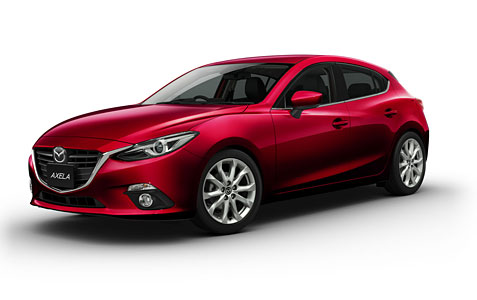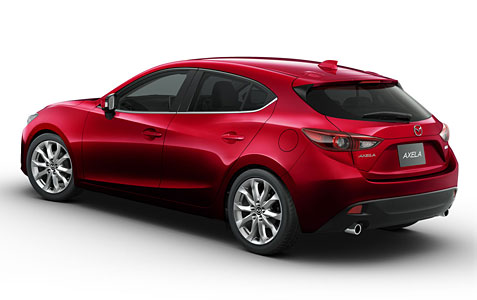Car Review: 2014 Mazda3 S Grand Touring

The new 2014 Mazda3 S is a big deal, because the redesigned compact vehicle is the Mazda’s best-selling and most recognizable nameplate worldwide with more than 3.5 million vehicles sold. We had the chance to drive the 2014 Mazda3 S in bitter cold temperatures with plenty of snow on the road to really put this car to the test.
This is one fine looking ride, and in titanium flash mica, the skin has a sleek and aggressive look. Lower and leaner than its predecessor, this third generation Mazda3 shares almost nothing with its older siblings other than a name. All new from the ground up, the 2014 Mazda3 sits on a wheelbase of 106.3 inches, which is 2.4 inches longer than the previous generation, yet the five-door is 1.8 inches shorter in length at 175.6 inches. Whether equipped with the standard 16-inch full-cover steel wheels or higher trim-equipped 16-inch and 18-inch aluminum alloy wheels, each set expresses dynamic motion from hub to rim. The Mazda3’s cab rearward posture and raked profile further emphasizes agility and speed.
From the dynamic signature wing of the five-point grille, to the expansive sheet metal cresting over sleekly slanted headlamps, to the wide-stance muscular fenders, to the taut character lines flowing from panel to panel, sculpting into a chiseled rear featuring provoking taillights, KODO begets the Mazda3 a presence unlike any other. Yet such style is not without purpose as the five-door and sedan models achieve best-in-class coefficient of drag (Cd) at 0.275 and 0.255, respectively, when equipped with i-ELOOP and an active grille shutter. A new-to-Mazda feature, the active grille shutter is mounted in front of the radiator and automatically opens and closes in accordance with driving conditions to improve aerodynamic performance while contributing to real-world gains in fuel economy.
Mazda took things to a whole new level with the cabin space of the 2014 Mazda3 S Grand Touring. The interior will impress, starting with the driver-oriented cockpit. The pedals have been laid out symmetrically to the left and right of the driver’s center-line with a hinged organ-type accelerator pedal as standard for added safety and comfort. Designed not only to appeal to the senses, each control and function also is specifically placed with intuitive utility in mind. The less time spent focusing on adjusting knobs and tapping touch-screen commands, the more time a driver is engaged with the actual act of driving, being alert to what is on the road ahead and, therefore, being able to react quickly, accurately and safely.
For added precision, the base of the A-pillars have been repositioned 3.9 inches rearward to afford greater range of vision for both the driver and front passenger. The outside mirrors also are mounted onto the doors instead of the base of the A-pillar to expand the scope of visibility when looking over mirrors from the driver’s seat.
All-new for Mazda vehicles and being launched with the 2014 Mazda3 is a next-generation human-machine interface (HMI) system. Based on the heads-up cockpit concept, the new HMI system aims to help drivers maintain proper posture, concentrate on the road and drive more safely, even while handling larger amounts of information. The information used is divided into groups, and an innovative screen layout is employed to let the driver safely balance the primary job of driving with other peripheral information.
The 2014 Mazda3 also is the first vehicle to feature Mazda’s all-new Active Driving Display, a clear pop-up panel that displays vehicle speed, navigation directions and other important driving information, and is vertically mounted behind the meter hood. This feature not only places necessary information comfortably in the driver’s line-of-sight but also directs the display beyond the instrument panel, more in line with where a driver’s eyes are naturally focused. The Active Driving Display panel will automatically fold back into a hidden position when the ignition is shut off.
The redesigned meter cluster features a centrally positioned analog gauge flanked by a pair of wing-shaped digital displays. The dial face for the center gauge is characterized by three-dimensional metallic numerals, evidence of the design teams’ attentiveness to detail, while its red-ring border pulses as soon as the driver’s door is opened, a nod to the vehicle’s inescapable sporty DNA. From the gauge clusters extends a decorative dash panel finished in satin chrome with piano black trim pieces adorning select areas of the center console and front door inserts.
The seat architecture has been redesigned with added focus on comfort and space, while at the same time reducing weight. For example, the front seat backs were further sculpted to provide rear seat passengers more knee room than the previous generation Mazda3, and shoulder room for all passengers increased as well. Additionally, the driver’s seat cushion was made larger, while still optimizing the seat back to create a more natural seating position with ample lateral support, a welcome adjustment for those prone to long drives. It’s hard to appreciate the space in the cabin until you either test drive a 3 or get lucky enough to go for a ride as a passenger.

The new operating system connects via Bluetooth to a smartphone and can easily be updated to ensure users always have access to the latest features and services without the need to swap out hardware. In addition to the current music access points via standard AM/FM radio, CD and USB/auxiliary port connections and premium content such as Sirius Satellite Radio, new features such as internet-based apps Aha by HARMAN will be available. An optional Bose premium audio system with Centerpoint 2 virtual surround sound playback will bring the harmonies and vocals to life for even the most discerning of audiophiles.
The system can also read email and short messages aloud while the vehicle is in motion using text-to-voice technology. Short Message Service (SMS) messages can be received and shown on the touch screen monitor. The system can then articulate the messages as well as allow users to send replies using fixed phrases. A new speech recognition system also allows users to repeat and shuffle audio tracks, as well as search and select folders. When connected with a smartphone, Twitter and Facebook updates can be read by the system with audio responses available using the Shout function. The system also allows users to search the internet for locations and map directions. An SD card-based navigation system is optional.
A new lightweight material that exhibits a high level of noise absorption is introduced on the dash insulator and floor mats, and insulating material also is positioned for maximum effectiveness behind the instrument panel. These measures achieve a level of cabin quietness that is highly competitive within the compact car class, and fully comparable in a class-above vehicle.
Power is a cinch with the SKYACTIV-G 2.5-liter engine, which at low- to mid-range speeds is increased by 10 to 15 percent, and its weight is reduced by 10 percent. The SKYACTIV-G 2.5-liter with automatic transmission as tested produces a peak of 184 horsepower at 5,700 rpm and 185 lb-ft of torque at 3,250 rpm. Once you get moving in the 2014 Mazda3 S Grand Touring, you can feel the road just enough to appreciate it, but we noticed the exceptional handling more than anything else. Straight line stability, tire grip and ride comfort have been greatly improved by tuning the suspension system’s springs, dampers and stabilizers. Mazda’s new mechatronic column-type electric power assist steering system is compact and lightweight, with a gearing ratio of 14.0:1. The brake response was also improved to be even more responsive, allowing for excellent vehicle control and feel as well as a braking distance amongst the best in the segment. Such improvements also reduce rolling resistance, all improving fuel economy. With the automatic fuel efficiency came in at 28 mpg in the city and 38 mpg in highway driving.
Safety is also stepped up with impressive additions such as High Beam Control (HBC), which automatically switches the headlamps between high and low beams, and Blind Spot Monitoring (BSM), which detects objects located in blind-spot areas to the sides and rear of the vehicle and issues a visual alert within the outside mirrors for the driver to see. Should the turn signal be on for the direction in which the “blind” object is located, audible beeps will alert the driver. Lane Departure Warning System (LDWS) monitors the lane markings on the road and issues a warning to the driver when it predicts that the vehicle is going to depart from its lane, while Forward Obstruction Warning (FOW) monitors the vehicle ahead and issues both audible and visual alerts to help the driver take evasive action when it determines a high risk of collision to exist. FOW operates when traveling between speeds of 9 and 92 mph and when traveling at speeds of less than 19 mph, Smart City Brake Support (SCBS) helps prevent or minimize a collision with a vehicle. Should the imbedded laser sensor detect an object, and the system calculates there may be a high risk for collision, the brake pedal travel is reduced in order to hasten braking. Should the driver fail to perform an avoidance maneuver, the system will activate an automatic braking function.
The compact car segment is crowded and getting squeezed with more competition arriving every day. The 2014 Mazda3 S Grand Touring upped the score this time around with a package that will win over hearts everywhere. We obviously had a loaded media car that stickered out at $29,185, and let me tell you that every feature made life better in subzero temperatures with plenty of snowfall. The heated seats were quick to warm up and the traction control system was a gem. Overall, this is a wonderful machine that looks great and doesn’t break the bank.
Related Posts
Comments Off on Car Review: 2014 Mazda3 S Grand Touring
Posted in: Car Reviews, Cars







